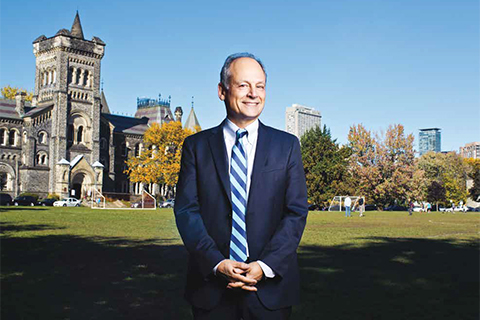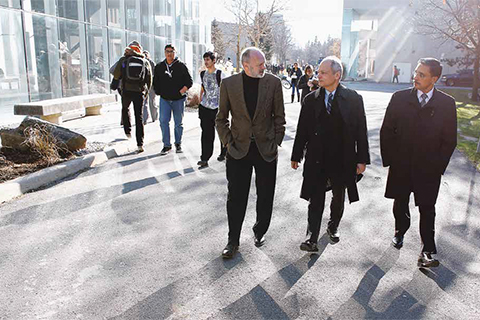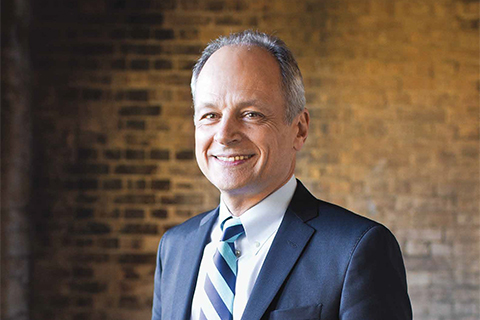Meric Gertler, the University of Toronto’s 16th president and an economic geographer by training, has spent his career trying to understand why some regions prosper and others don’t. He’s probed the question of how – and why – capital and talented people tend to gravitate toward those cities that value qualities such as tolerance, education and culture. And he’s devoted many hours to sharing these insights not just with other academics, but also with the corporate leaders, policymakers and politicians who can translate those findings into policies meant to stoke a region’s economic growth.
Given that decidedly urban-minded background, does Gertler feel like he’s suddenly become the mayor of U of T?
On a gusty afternoon a few weeks before his installation ceremony in early November, Gertler relaxes at a small table in a spare Simcoe Hall office. He chuckles briefly at the suggestion but quickly picks up the thread. “Well, you know, we have 80,000 students and more than 10,000 faculty and staff. It’s a mid-sized city.” He rhymes off the parallels to a large and thriving metropolis: “We have all the advantages of being large and at the same time there are these small communities that take a very large place and make it intelligible and friendly and approachable.” The obvious analogy, he adds, is Toronto itself: “The U of T is also a city of villages.”
As Gertler moves from being an astute observer of the urban condition to presiding over one of the city’s leading institutions, he has braced himself to confront the daunting challenges that come with serving as chief magistrate.
Job one: reversing what he sees as a worrisome deterioration in public funding that could threaten U of T’s hard-won status as one of the world’s top universities. “Our position is already compromised, globally and nationally,” Gertler warns. With limited funding for international graduate students, for example, U of T has no choice but to restrict admissions despite the deluge of interest abroad in the university’s research programs.
He comes in with a mandate to complete the university’s ambitious $2-billion fundraising campaign. Judy Goldring, chair of Governing Council, adds that the new president – whose appointment was announced last March after a search for a successor to former president David Naylor – will continue to look for ways to further improve the student experience. He won’t get much downtime. Goldring notes that Gertler’s new role “is one of the toughest jobs. It is literally a 24–7 job.”
For his part, Gertler, who until this spring served for five years as dean of the Faculty of Arts and Science, wants to build on the transformation of undergraduate teaching and learning in recent years and forge broader institutional relationships with international universities. He also believes that U of T must become much more actively engaged with the affairs of the Toronto region, establishing more partnerships with public- and private-sector organizations, other post-secondary institutions and civil society groups. “We need to acknowledge and embrace our role as a city-builder, in the three parts of the metropolitan region in which we reside,” he says.
Indeed, after years spent scrutinizing the way creative city-regions function, Gertler feels that it’s crucial for educators, researchers and academic institutions to be able to tap into the informal knowledge that exists in Toronto’s diverse communities and draw on the city’s vibrancy. In his view, the university’s relationship with the region is mutually reinforcing.
“U of T would not be the success it is today were it not situated in one of the world’s great cities.”
The university, he adds, has thousands of students “thirsting” for experiential learning programs that could be expanded and augmented in conjunction with local groups. U of T, meanwhile, can also serve as a venue for public debates and discussions about a wide array of city-related issues – everything from electoral reform and income disparity to the suitability of casinos in waterfront settings. “I think a lot of my academic colleagues are drawn to these questions because they are inherently so compelling,” Gertler says. “Toronto is a great lab.”
Gertler, who’s 58, has built an international academic reputation in a red-hot discipline, and proved himself as a determined administrator through his stint as dean of Arts and Science. He’s lived for years in the Annex with his partner Joanna, who is director of marketing and communications for Canada’s National Ballet School. The couple has two children – a 23-year-old son who has a degree in architecture and is planning to go to grad school and a 26-year-old daughter who works in advertising research.

Despite a new role that places him at the very pinnacle of Canada’s post-secondary universe (and which will be accompanied by a move to the president’s official residence in Rosedale), Gertler comes across as unassuming, approachable and imperturbable – traits that colleagues say have helped him build an extensive network of peers in a wide range of disciplines, as well as influential contacts outside the halls of academe.
David Wolfe, the Royal Bank Chair in Public and Economic Policy at U of T Mississauga and Gertler’s long-time research partner, says that the new president’s most conspicuous skill is his ability to synthesize and distill the large swaths of information that flow into major academic projects. After absorbing detailed presentations from his research teams, Gertler will step in and lay out the accepted facts and identify points of agreement and disagreement. “I’ve seen him do it countless times in a research network setting,” says Wolfe, who adds that Gertler frequently reminds him of the late David Pecaut, a management consultant and skilled communicator who created a multi-stakeholder advocacy group to push for urban reforms in Toronto. “There’s a process of thought leadership involved.”
“He understands the give and take,” adds Roger Martin, former dean of the Rotman School of Management, who credits Gertler for showing leadership as dean of Arts and Science. “But he plays to win.”
Enid Slack, an expert at the Institute on Municipal Finance and Governance at the Munk School of Global Affairs, notes that while Gertler never shies away from articulating his own perspective, he does so in a collegial manner. “If he agrees with you, he’ll tell you, and if he doesn’t agree, he’ll tell you in a very respectful way.”
Slack points out that the university’s many urban scholars are particularly enthusiastic about Gertler’s appointment to the presidency, which coincides with this fall’s launch of U of T’s Global Cities Institute, as well as the creation of a significantly expanded urban studies hub in the John H. Daniels Faculty of Architecture, Landscape and Design. “His commitment to cities, and cities in a global context, means so much for advancing the cities agenda in a meaningful way,” says Patricia McCarney, director of the Global Cities Institute.
U of T’s new president was born in Edmonton and grew up in Toronto, St. Catharines and Waterloo, Ontario. As a young man, his father, Leonard (Len), tried his hand at filmmaking, but later trained as an urban planner. He went on to work for local governments, including a seven-year stint as a deputy commissioner of planning for the City of Toronto. In 1966, he relocated to the University of Waterloo to found its planning program, and is best known for writing a groundbreaking land-use report that led to the protection of the Niagara Escarpment.
The subject of urban planning was a much-discussed topic in the Gertler home, recalls Meric. “It was certainly dinner table conversation from the earliest days.” But he says that his own fascination with cities developed organically as he began to discover Toronto as a boy. In the mid-1960s, Gertler recalls, it was very easy for him and his friends to use transit to travel around the city and explore.
He adds that he became even more acutely aware of Toronto’s cosmopolitanism after the Gertler family relocated to Waterloo. At the time, the university was very new, and Waterloo – its economy built around insurance and agriculture – lacked the tech-hub vibrancy it enjoys today. The town-gown divide was pronounced. And from the perspective of a teenager, the dearth of transit service in Waterloo proved oppressive: if Gertler wanted to go anywhere, he had to rely on his parents for a drive. He realized, with the benefit of hindsight, how much freedom the big city conferred. “That was kind of an epiphany.”
With the urban exploration and the moves came a growing curiosity about why some cities work and others don’t, and why some neighbourhoods are more engaging than others. “These questions were very much on my mind from an early age,” recalls Gertler. The move to Waterloo, he adds, “got me thinking about what drives cities and what creates the dynamism of a certain place.”

After high school, he went to McMaster University to study geography, and then enrolled in a master’s of urban planning at the University of California, Berkeley, in 1977. At a 2005 memorial service for his father, Gertler pointed out that “Len never cajoled or coaxed me.” Yet, as Sandra Martin noted in a Globe and Mail obituary, Meric was drawn inexorably to the profession because Len’s work was “so damned interesting. [It made] a difference to the quality of our lives and our communities at a time when public interest in ‘the environment’ and all things ‘urban’ was enjoying its first real flowering in this country.”
After graduating from Berkeley, Gertler spent a year working as a policy analyst with the Ontario government’s ministry of industry and tourism. He says the experience was an “eye opener.” The job “gave me a ringside seat to how various interest groups try to shape decision-making.” He eventually came to regard the horse-trading as an integral part of the democratic process.
By the time he began his PhD at Harvard University’s Graduate School of Design, Gertler’s personal, academic and professional experiences began to coalesce into a serious focus on regional economic development, and how places reinvent themselves from centres of older economic activity to newer forms.
In 1983, soon after completing his thesis, Gertler joined U of T’s geography department. Urban economic geographer Larry Bourne, who was on the hiring committee, recalls the new professor as being “mature beyond his years,” with the confidence and intellectual rigour to move quickly to the forefront of a department that had developed, since the 1960s, a global reputation among urban experts.
Over two decades, Gertler has worked closely with David Wolfe, studying why regions such as Silicon Valley attract vibrant technology- and innovation-driven industries. This research has overlapped with Gertler’s other major focus – how cities attract and foster talent, a.k.a. the “creative class,” a phrase made famous by urbanist Richard Florida, who joined U of T in 2007 to head the Martin Prosperity Institute at the Rotman School of Management. “Meric was on the cutting edge of understanding why clusters of firms are important to innovation,” says Florida, who met Gertler at an academic conference in the mid-1980s. Long before he published The Rise of the Creative Class (2002), Florida recalls that Gertler would press him to come up to Toronto for conferences, whereupon he’d show off the city’s walkable neighbourhoods, dim sum eateries and steamer-tray restaurants.
As they joined forces to map the geography of specialized clusters and creative-class cities, Gertler and Florida came to realize that Toronto wasn’t just a good place to go out for international food and a stroll. The city’s surging economy, the influx of newcomers and an array of thriving sectors suggested that the Toronto region had figured out how to bring together the so-called “three Ts” – talent, technology and tolerance. “I think we’re all inspired by the very interesting case study around us in the Toronto region,” says Gertler. “It’s been a great setting in which to encourage people to work on these issues.”
Not surprisingly, Gertler’s mapping of the geography of creativity and innovation has come to include post-secondary institutions and their role in the evolution of regional clusters and knowledge driven urban economies. As part of Bob Rae’s 2005 review of postsecondary education in Ontario, Gertler authored a study that situated universities in a broader context of regional economic development. By attracting talented researchers and graduate students from around the world, universities advance not just innovation but also a range of broader social objectives. From a policy perspective, Gertler noted, universities should not be seen as mere “knowledge factories.” “The university,” he wrote, “can act as a catalyst for economic development, but – more importantly – the university is also a crucial actor in making places more open and diverse, thereby contributing to wider goals of social inclusion and cohesion within Canadian society.”
David Wolfe, in fact, suggests that this essay, published in 2004, is something akin to a personal manifesto. “If someone wants a clue to Meric’s thinking, that paper might be the first thing you’d read.”
***
In the months following his appointment as president, Gertler decided to take a road trip, visiting a series of cities with thriving universities to examine how those institutions engage with their host communities. The journey took him to global centres such as London and Chicago. But it also took him to Baltimore, where Johns Hopkins University is participating in an ambitious partnership to redevelop some of the city’s lowest-income communities that fan out from near the downtown campus. (Johns Hopkins president, Ron Daniels, is a former dean of law at U of T.)
London’s story is even more interesting, Gertler says. There, more than 40 universities, colleges and other educational institutions, representing 420,000 students and consuming £1.2 billion in public funds, have banded together in an umbrella organization called “London Higher,” with the goal of promoting the “influence and capacity” of the region’s higher education sector. The group has commissioned studies on student housing, the relationship between post-secondary institutions and the London job market, and the economic contribution of international students (see facing page).
“They’ve been very effective,” Gertler says, noting that one of the group’s recent successes involved persuading the national government to adjust funding levels to London’s post-secondary institutions to reflect the city’s high cost of living. The approach, he adds, “is an idea worth exploring.” Indeed, Gertler and former president David Naylor gathered in a Toronto bistro recently to informally discuss such ideas with Ryerson University president Sheldon Levy, York University president Mamdouh Shoukri and some of Toronto’s other post-secondary leaders.
Florida argues that the university ought to forge even deeper policy ties with the city and the Greater Toronto area, positioning itself as an “honest broker” in broader conversations about governance, regional planning issues and the economic development goals of Canada’s largest urban region. “Toronto is at kind of an inflection point,” he says. “The university could use its urban capabilities to rethink these issues.”
Gertler agrees, and argues that the university has an “enlightened self-interest” in the mutually reinforcing relationship between a healthy city-region and the wellbeing of its post-secondary institutions. And he has the data to prove it.
Journalist and author John Lorinc (BSc 1987) writes about politics and urban issues for The Globe and Mail, The Walrus and Spacing magazine. He is the author of The New City: How the Crisis in Canada’s Urban Centres is Reshaping the Nation (2006).






